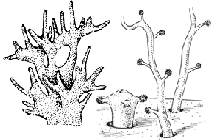WoRMS taxon details
Milleporidae Fleming, 1828
196235 (urn:lsid:marinespecies.org:taxname:196235)
accepted
Family
Milleporadae Fleming, 1828 · unaccepted (incorrect formation of family name)
- Genus Millepora Linnaeus, 1758
- Genus Palmipora de Blainville, 1834 accepted as Millepora Linnaeus, 1758 (synonym)
marine, brackish, fresh, terrestrial
recent + fossil
Not documented
WoRMS (2024). Milleporidae Fleming, 1828. Accessed at: https://www.marinespecies.org/aphia.php?p=taxdetails&id=196235 on 2024-09-20
Date
action
by
![]() The webpage text is licensed under a Creative Commons Attribution 4.0 License
The webpage text is licensed under a Creative Commons Attribution 4.0 License
original description
(of Milleporadae Fleming, 1828) Fleming, J. (1828). A history of British animals, exhibiting the descriptive characters and systematical arrangement of the genera and species of quadrupeds, birds, reptiles, fishes, Mollusca, and Radiata of the United Kingdom; including the indigenous, extirpated, and extinct kinds, together with periodical and occasional visitants. <em>Edinburgh, Bell & Bradfute / London, James Duncan.</em> Pp. i-xxii, 1-565. corrigenda., available online at http://www.biodiversitylibrary.org/item/18569
page(s): 528 [details]
context source (MSBIAS) MEDIN. (2011). UK checklist of marine species derived from the applications Marine Recorder and UNICORN. version 1.0. [details]
page(s): 528 [details]
context source (MSBIAS) MEDIN. (2011). UK checklist of marine species derived from the applications Marine Recorder and UNICORN. version 1.0. [details]
 Present
Present  Inaccurate
Inaccurate  Introduced: alien
Introduced: alien  Containing type locality
Containing type locality
From editor or global species database
Diagnosis Hydroid colony forming massive, calcareous exoskeletons (= coenosteum) of varied shape; coenosteum with an internal complex network of coenosarcal tubes and covered externally by a thin ectodermal layer, coenosteal surface perforated by pores; margins of pores not elevated; large gastropores surrounded by smaller dactylopores, forming indistinct cyclosystems; polyps polymorphic; gastrozooids relatively short and stout, with an oral whorl of four to seven short capitate tentacles, arising from gastropores; dactylozooids long, slender, mouthless, with scattered capitate tentacles, arising from dactylopores; cnidome with stenoteles and macrobasic mastigophores; gonophores arising from coenosarc within chambers embedded entirely in the coenosteum. Medusa free swimming eumedusoids with exumbrellar nematocyst patches, radial and circular canals present, without tentacles and sense organs; gonads occupying the place of an indistinct manubrium. [details]
| Language | Name | |
|---|---|---|
| Japanese | アナサンゴモドキ科 | [details] |

